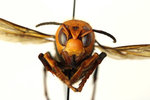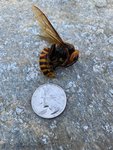


The first confirmed sighting of an Asian giant hornet in Washington state this year was in Whatcom County, according to the Washington State Department of Agriculture.
On Wednesday, May 27, a resident near Custer found a dead hornet while walking on a road, the agency said.
The resident sent in a photo and report using the department's online Hornet Watch Report Form, agriculture officials said in a news release on Friday, May 29.
On Thursday, May 28, the department's entomologists concluded that the photo appeared to show an Asian giant hornet. The dead hornet was collected and submitted for laboratory testing the same day.
State and federal labs confirmed that the specimen was an Asian giant hornet on Friday, May 29.
The hornet was found near the location of a suspected Asian giant hornet bee kill in 2019, the agriculture department said in the release.
Agriculture officials already planned to set up traps in the area and will continue with that plan to try to find any colony that may be there.
Sven Spichiger, the department's managing entomologist, will hold a virtual press conference at noon Friday to discuss the find.
The Washington State Department of Agriculture and beekeepers in Whatcom County have been setting traps for the invasive pests since spring after they were first seen in the county last year.
A Blaine-area homeowner found a dead one on his property on Dec. 8, 2019, and reported seeing a live one near a hummingbird feeder before it flew into a nearby wooded area.
Those 2019 sightings were the first of the invasive honeybee-killing hornets known for their powerful, painful stings in Washington state and the U.S. About the size of an adult thumb, the Asian giant hornet, or Vespa mandarinia, is the world's largest hornet.
State agriculture officials don't yet know how widespread of a problem the hornets -- now widely known as "murder hornets" because of a recent New York Times article -- are in Whatcom County or Washington even as they've started to set up traps.
They've asked beekeepers and the public to help as well, either by trapping or reporting suspected hornets.
The traps set up so far were for the Asian giant hornet queens as they emerge in the spring to set up colonies. The goal is to find and destroy the hornets and prevent the pests from reproducing and taking hold in the Pacific Northwest.
Their native range is Asia, and they are not wanted here.
The hornets also are known as the Japanese hornet, yak-killer hornet and the giant sparrow bee. Their stingers are longer than typical, native wasps, so each sting delivers more venom.
Asian giant hornets can be nearly 2 inches long and are identifiable by their large yellow/orange heads.
Because they're new to Washington state, officials here are relying on the knowledge of their counterparts in China, Japan and Korea.
___